Plant Profiles
Click on the first letter of the common name of the plant you wish more information about.
A | B | C | D | E | F | G | H | I | J | K | L | M | N | O | P | Q | R | S | T | U | V | W | X | Y | Z
T
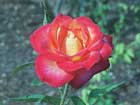
Tea Rose, Hybrid
Scientific Name: Rosa hybrids
Growth Habit: Evergreen shrubs with an upright to slightly rounded shape growing to 6 feet tall and almost as wide; produces prickly stems with compound leaves having three, five or seven segments.
Light: Plant in full sun.
Feedings: Fertilize monthly with a general garden fertilizer or a product labeled for roses.
Water Needs: Prefers a moist soil; water every three to four days during the hot, dry seasons.
Ease of Culture: Medium; roses need regular care.
Propagation: By budding or from cuttings.
Hardiness: Hardy; severe freezes may damage leaves and stems.
Major Problems: Most rose selections are affected by black spot, a disease, and mites which can cause defoliation that weakens the plants. Sprays are usually needed. Other problems that may need control: thrips, caterpillars and powdery mildew.
Pruning: In mid-February, plants are reduced in size by one-third to one-half to control plant size and renew growth. Grooming to remove old flowers, lanky shoots and diseased or dead portions is performed year-round.
Uses: Hybrid tea roses often are planted in beds of assorted varieties. Flower colors include all but blue and may be a single color or a blend such as variety Perfect Moment (above). Single specimens also can be grown as accents with perennials or in containers to display on a sunny balcony or patio.
Florida Native: No; all are hybrids with mixed parentage.
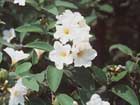
Texas Wild Olive
Scientific Name: Cordia boissieri
Growth Habit: A small, round evergreen tree growing to 20 feet tall. Six-inch oblong leaves are dark green on top, grayish underneath.
Light: Plant in full-sun locations.
Feedings: Fertilize new trees with a general garden fertilizer once in March and June for the first three years. Established trees do not need special feedings and obtain needed nutrients from nearby feedings.
Water Needs: Keep new trees moist until the roots grow into the surrounding soil. Established trees are drought tolerant, usually existing on moisture from seasonal rains.
Ease of Culture: Easy.
Propagation: Start new trees from seed or air layers.
Hardiness: Hardy.
Major Problems: Caterpillars may feed on the large leaves. Control as needed with a natural Bacillus thuringiensis-containing spray.
Pruning: Maintain a straight single trunk with evenly spaced limbs around the trees until over 8 feet tall. The tree then can be allowed to branch and develop the rounded habit. Remove lower limbs as needed to permit traffic and landscape maintenance.
Uses: The Texas wild olive, also called white geiger tree, is a nice discovery. It can be planted as an accent tree near the patio or an entrance. Also add it as a focal point near flower beds and along walkways. It flowers almost constantly March through November, opening clusters of delicate-looking 2-inch white blossoms.
Florida Native: No; native to Texas and Mexico.
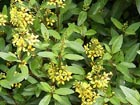
Thryallis
Scientific Name: Galphimia glauca
Growth Habit: A rounded, evergreen, dense shrub growing to 6 feet tall and wide. The leaves are oblong, growing to 2 inches long and half as wide.
Light: Plant in full sun to light shade.
Feedings: Apply a general garden fertilizer once monthly in March, June and September.
Water Needs: Tolerates short periods of drought; grows best with weekly waterings.
Ease of Culture: Easy.
Propagation: Start plants with seeds or cuttings.
Hardiness: Hardy; might be damaged by severe freezes but grows back from lower stem portions.
Major Problems: Plants are brittle. Keep away from pathways where visitors or hoses might damage the plants. Occasionally affected by caterpillars, but controls are seldom needed.
Pruning: Plantings can be trained as a formal hedge but much of the natural beauty is lost. It's best to remove out-of-bounds limbs selectively throughout the growing season. Plantings might be reshaped as needed in late winter before spring growth begins.
Uses: Add to foundation plantings for summer displays of bright yellow flowers opening May through November. Might be used to create accents and view barriers and as a backdrop for gardens and lower-growing shrub displays. Thryallis sometimes is added to planters and large container gardens.
Florida Native: No; native to Guatemala and Mexico.
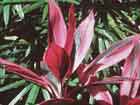
Ti Plant
Scientific Name: Cordyline terminalis
Growth Habit: An upright tropical perennial often producing shoots from buds near the ground, growing stems of foliage to 6 feet tall. Leaves are multicolored, oblong and growing to over 2 feet long and 6 inches wide.
Light: Tolerates full sun; grows best in filtered sun to shady locations.
Feedings: Apply a general garden fertilizer once every six to eight weeks March through November for in-ground plantings. Feed container-grown plantings monthly.
Water Needs: Tolerates short periods of drought; grows best with weekly waterings.
Ease of Culture: Easy.
Propagation: Start plants from cuttings.
Hardiness: Tender; damaged by frosts and freezes. Plants protected by trees and mulches usually grow back from shoots near the ground.
Major Problems: Check plants frequently for mealybugs and mites and treat with a natural soap or oil spray as needed. Older leaves also appear to be susceptible to leaf spots and are best removed when noted.
Pruning: Remove cold-damaged leaves and stems at the end of February to prepare the plants for spring growth. Plants often grow rapidly and may need occasional trimming to reduce plant height and remove weak shoots. This trimming also encourages multiple shoots.
Uses: Cluster plants along walkways and near patios to form accents of brightly colored blends of red, green, yellow and pink foliage similar to variety Red Sister (pictured). Plantings also can be used as a ground cover to fill gardens or as a backdrop for shorter growing flowers. Add ti plants to container garden displays on patios, balconies and indoors. The flowers are white to pink and not showy.
Florida Native: No; native to Eastern Asia.

Triostar Stromanthe
Scientific Name: Stromanthe sanguinea 'Triostar'
Growth Habit: An evergreen tropical perennial grown as a foliage plant with multiple shoots forming a rounded plant that grows to 30 inches tall and wide. The lancelike leaves of this variety are green with white-and-red markings, and they grow to 18 inches long and 4 inches wide.
Light: Grow in bright light but out of direct sun.
Feedings: Apply a 20-20-20 or similar fertilizer every other month March through November. No fertilizer is needed during the cooler months.
Water Needs: Prefers a moist soil; water when the surface soil begins to dry. Plants also benefit from regular misting to increase the humidity.
Ease of Culture: Easy.
Propagation: Start plants of Stromanthe by cuttings or by dividing older clumps.
Hardiness: Tender; grows best at temperatures above 50 degrees.
Major Problems: Keep plants moist, but avoid overwatering, which can cause root-rot problems. Plants in this genera are also susceptible to mite and mealybug infestations, which can be controlled with a natural spray as needed.
Pruning: Remove declining leaves as needed to maintain an attractive plant.
Uses: Members of the Stromanthe genera have quickly become popular foliage plants for the home and patio. Selection Triostar offers year-round attractive green, red and white leaves to create an eye-catching accent among other greenery and when used as a tabletop or floor display. Plants can be added to the landscape for the tropical look but are best grown in containers to move to warmer spots during the cooler months.
Florida Native: No; native to Brazil.
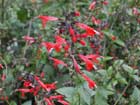
Tropical Sage
Scientific Name: Salvia coccinea
Growth Habit: An upright to rounded evergreen perennial growing to 3 feet tall and wide. The leaves are ovate in shape, with toothed margins growing to 2 inches long and 1 inch wide.
Light: Plant in full sun to light shade for best flowering.
Feedings: Apply a general garden fertilizer every other month March through November.
Water Needs: Drought tolerant; maintain a light mulch, and water every other week during hot, dry weather.
Ease of Culture: Easy.
Propagation: Start plants from seed.
Hardiness: Tender; damaged by heavy frosts and freezes but grows back from lower stems or seeds.
Major Problems: Plant may be damaged by grasshoppers and caterpillars, but controls seldom are needed. Plantings reseed readily and tend to be invasive.
Pruning: Remove declining flower heads to prevent reseeding and to keep the plants attractive. Periodically, give a hard pruning to keep plantings in bounds. Most plantings also need pruning to remove cold-damaged portions before spring growth.
Uses: A colorful flower for perennial and wildflower gardens, producing year-round displays of foot-tall spikes of bright-red blooms that attract butterflies and hummingbirds. More recent selections include varieties with pink, white and pink-and-white flowers. Plants also can be added to container gardens.
Florida Native: Yes.
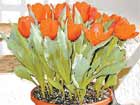
Tulip
Scientific Name: Tulipa hybrids
Growth Habit: An upright spring-flowering perennial bulb that produces quick growth up to 18 inches tall and 6 inches wide, then flowers and declines before summer. The leaves are bright to blue-green in color, lancelike and clasping a central stem; they grow to 6 inches long and half as wide.
Light: Grow or display in full sun to light shade.
Feedings: No fertilizer is applied to tulips forced for local container or garden plantings.
Water Needs: Tulips need moist soil when growing; water when the surface begins to dry.
Ease of Culture: Easy, to enjoy the flowers of forced bulbs; difficult, to prepare the bulbs for forcing.
Propagation: Start plantings from bulbs.
Hardiness: Hardy.
Major Problems: Tulips require more cold than Florida's climate provides to flower. Forced tulip bulbs normally are enjoyed for their blooms and then treated as a bouquet. They are added to the compost pile as they decline. The plants are usually in bloom for about a week, which is a relatively short period of time for flowers.
Pruning: None needed. Taller-growing selections may need staking to prevent wind damage or collapsing because of weak stems when grown in lower light locations.
Uses: Tulips available in a variety of colors are usually purchased locally as forced bulbs growing in containers about to bloom. They are displayed in the home under bright light, on sunny porches or patios and at entrances. Plants about to bloom also can be set in beds for an attractive but short-lived display. Some gardeners buy bulbs to store in a refrigerator for 12 weeks during the fall and then add to the garden for winter blooms. To be successful, the refrigerator must not be used to store fruits or vegetables at the same time.
Florida Native: No; native to Eastern Europe and Asia Minor.
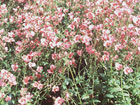
Twinspur
Scientific Name: Diascia barberae
Growth Habit: An upright to slightly arching evergreen perennial growing to 12 inches tall and 24 inches wide. The leaves are bright green and heart-shaped, growing to 1 inch long and wide.
Light: Plant in full sun to lightly shaded locations.
Feedings: Apply a general garden fertilizer monthly to in-ground plantings; feed container plantings every other week.
Water Needs: Prefers a moist soil; water in-ground plantings at least weekly and container gardens when the soil surface begins to dry.
Ease of Culture: Easy.
Propagation: Start plants from cuttings or seeds.
Hardiness: Tender; grows best during the cooler weather, but protect from frosts and freezes.
Major Problems: Declines during hot, rainy weather. Best to treat this perennial as a cool-season annual for Florida. Plants may be attacked by slugs and snails that can be controlled by handpicking or using baits available from garden centers.
Pruning: Trim old flower heads to encourage new shoots with additional blooms. Remove declining plants and replace with warm-season flowers in early summer.
Uses: A new plant just appearing at garden centers with attractive cool-season color for flower gardens, planters and hanging baskets. Clusters of eye-catching pink blossoms open on long stems held well above the foliage to attract butterflies and hummingbirds. Each blossom has two spurs that serve as a nectar source and give rise to the plant's common name.
Florida Native: No; native to South Africa.